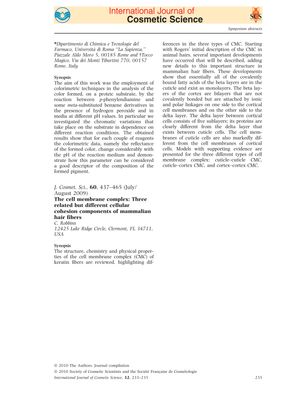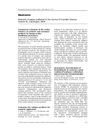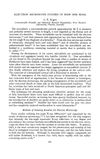The cell membrane complex: Three related but different cellular cohesion components of mammalian hair fibers
May 2010
in “International Journal of Cosmetic Science”

TLDR The cell membrane complex in mammalian hair has three distinct types with different structures and chemical properties.
The document reviews the structure, chemistry, and physical properties of the cell membrane complex (CMC) in mammalian hair fibers, emphasizing the differences in the three types of CMC. It builds upon Rogers' initial description of the CMC, presenting new developments that reveal the covalently bound fatty acids of the beta layers are predominantly in the cuticle as monolayers. The beta layers of the cortex are bilayers, attached by ionic and polar linkages to the cortical cell membranes on one side and to the delta layer on the other, but are not covalently bonded. The delta layer, consisting of five sublayers, differs between cortical cells and cuticle cells, with distinct proteins. The cell membranes of cuticle cells are also significantly different from those of cortical cells. The paper presents models with supporting evidence for the three types of CMC: cuticle-cuticle CMC, cuticle-cortex CMC, and cortex-cortex CMC.
View this study on onlinelibrary.wiley.com →
Cited in this study
research Characterization of the lipid composition at the proximal root regions of human hair
Human hair contains various lipids that vary among individuals and help protect the hair.
research Change in surface chemistry of the cuticle of human hair by chemical and photochemical oxidation
Oxidation changes human hair by breaking down fats and forming new acidic groups, affecting how it interacts with conditioners and cosmetics.

research Failure of intercellular adhesion in hair fibers with regard to hair condition and strain conditions
Hair breaks differently when wet or dry and is affected by its condition and treatments like perms and bleaching.
research Fractography of human hair
research Degradation Of Human Hair By Papain
